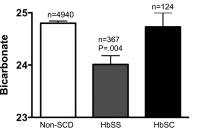Kidney Disease among Patients with Sickle Cell Disease, Hemoglobin SS and SC
- PMID: 26672090
- PMCID: PMC4741034
- DOI: 10.2215/CJN.03940415
Kidney Disease among Patients with Sickle Cell Disease, Hemoglobin SS and SC
Abstract
Background and objectives: Sickle cell disease (SCD) is an inherited anemia that afflicts millions worldwide. Kidney disease is a major contributor to its morbidity and mortality. We examined contemporary and historical SCD populations to understand how renal disease behaved in hemoglobin SS (HbSS) compared with HbSC.
Design, setting, participants, & measurements: Kidney function was examined in the multicentered Treatment of Pulmonary Hypertension and Sickle Cell Disease with Sildenafil Therapy (Walk-PHaSST) Trial (HbSS=463; HbSC=127; years 2007-2009) and historical comparator populations from the Cooperative Study of Sickle Cell Disease (CSSCD; HbSS=708) and the Multicenter Study of Hydroxyurea in Sickle Cell Disease (MSH; HbSS=299).
Results: In adults with SCD, eGFR was lower among older individuals: -1.78 ml/min per 1.73 m(2) per year of age (95% confidence interval [95% CI], -2.06 to -1.50; Walk-PHaSST Trial), -1.75 ml/min per 1.73 m(2) per year of age (95% CI, -2.05 to -1.44; MSH), and -1.69 ml/min per 1.73 m(2) per year of age (95% CI, -2.00 to -1.38; CSSCD) in HbSS compared with -1.09 ml/min per 1.73 m(2) per year of age (95% CI, -1.39 to -0.75) in HbSC (Walk-PHaSST Trial). Macroalbuminuria was seen in 20% of participants with SCD (HbSS or HbSC; P=0.45; Walk-PHaSST Trial), but microalbuminuria was more prevalent in HbSS (44% versus 23% in HbSC; P<0.002). In the Walk-PHaSST Trial, albuminuria was associated with hemolysis (higher lactate dehydrogenase, P<0.001; higher absolute reticulocyte count, P<0.02; and lower Hb, P=0.07) and elevated systolic BP (P<0.001) in HbSS. One half of all participants with HbSS (20 of 39) versus one fifth without (41 of 228) elevated tricuspid regurgitant jet velocity (≥3 m/s; adverse prognostic indicator in SCD) had macroalbuminuria (P<0.001). In the CSSCD, overt proteinuria, detected (less sensitively) by urine dipstick, associated with higher 3-year mortality (odds ratio, 2.48; 95% CI, 1.07 to 5.77). Serum bicarbonate was lower in HbSS (23.8 versus 24.8 mEq/dl in HbSC; P<0.05) and associated with reticulocytopenic anemia and decreased renal function.
Conclusions: In SCD, albuminuria or proteinuria was highly prevalent, in HbSS more than in HbSC. Proteinuria associated with mortality in HbSS. Older individuals had a lower than expected eGFR, and this was more prominent in HbSS. Current management does not routinely address renal complications in SCD, which could plausibly reduce morbidity and mortality.
Keywords: acidosis; albuminuria; anemia, sickle cell; blood pressure; chronic kidney disease; glomerular filtration rate; humans; hydroxyurea; hypertension, pulmonary.
Copyright © 2016 by the American Society of Nephrology.
Figures




References
-
- Baum KF, Dunn DT, Maude GH, Serjeant GR: The painful crisis of homozygous sickle cell disease. A study of the risk factors. Arch Intern Med 147: 1231–1234, 1987 - PubMed
-
- Ohene-Frempong K, Weiner SJ, Sleeper LA, Miller ST, Embury S, Moohr JW, Wethers DL, Pegelow CH, Gill FM: Cerebrovascular accidents in sickle cell disease: Rates and risk factors. Blood 91: 288–294, 1998 - PubMed
-
- Platt OS, Thorington BD, Brambilla DJ, Milner PF, Rosse WF, Vichinsky E, Kinney TR: Pain in sickle cell disease. Rates and risk factors. N Engl J Med 325: 11–16, 1991 - PubMed
-
- Powars DR, Chan LS, Hiti A, Ramicone E, Johnson C: Outcome of sickle cell anemia: A 4-decade observational study of 1056 patients. Medicine (Baltimore) 84: 363–376, 2005 - PubMed
-
- Powars DR, Hiti A, Ramicone E, Johnson C, Chan L: Outcome in hemoglobin SC disease: A four-decade observational study of clinical, hematologic, and genetic factors. Am J Hematol 70: 206–215, 2002 - PubMed
Publication types
MeSH terms
Substances
Grants and funding
LinkOut - more resources
Full Text Sources
Medical
Molecular Biology Databases
Research Materials
Miscellaneous

